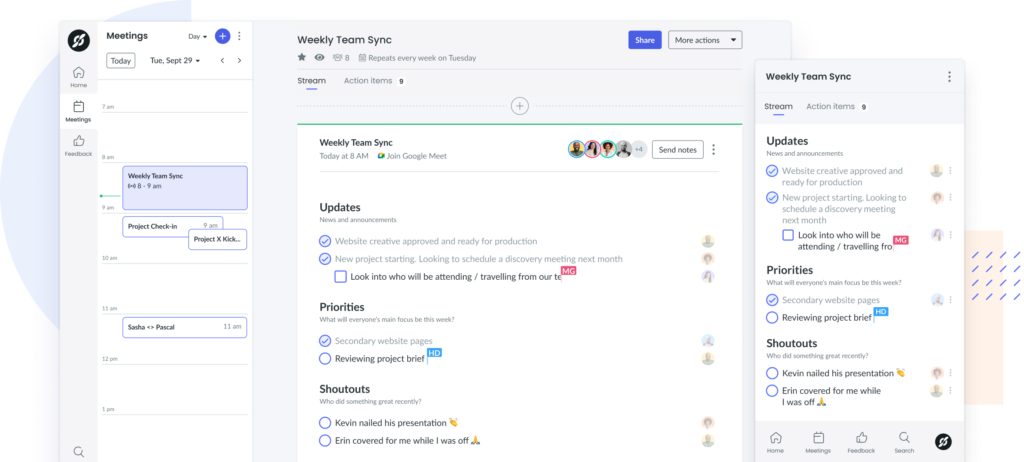
Running an effective sales meeting can help ensure that your team knows how their efforts lead to success. Read on for how to structure and run your sales meeting.
By Mara Calvello • September 22, 2021 • 7 min read In this article 7 min read In this article 7 min readIf you want your sales team to be as effective and productive as possible, where do you start?
Take a good look at your sales meeting and how thorough the agenda is. Does it need some work? If your sales reps leave each sales meeting thinking it could have been an email, the answer is a firm yes.
If it’s time to give your meeting agenda a complete overhaul, look no further than Fellow. We’re here to ensure that your days of unorganized and poorly run meetings are a thing of the past.
So, why hold a sales meeting in the first place?
For starters, they help the sales department to come together and connect. This will ensure that all expectations are aligned, it helps to foster group conversations and discussions. Each sales member can check in with one another, see if they can assist with a roadblock that a team member is facing, or come up with a solution the team as a whole may be facing.
These meetings can also serve as internal check-ins between sales leaders and practitioners.
Additionally, be sure to utilize sales meetings to:

Use a meeting management tool like Fellow to share a meeting agenda with your team and collaborate on achieving goals.

When holding a sales meeting, there are specific elements that you can be sure to incorporate for it to be a success. Consider adding these elements to run an effective sales meeting for all attendees.
Looking to start the sales meeting on a positive note? Consider kicking your sales meeting off in one of these ways:
The most productive meetings always start with an agenda. When creating the agenda for your sales meeting, be sure it includes these details. Doing so ensures everyone is prepared and ready for discussions.
The first action item to add to the agenda is wins and successes. Have your sales reps and managers share a recent win they’ve had to get the conversation started. If a team member closes a major deal, has some exciting insights to share, or if the team is estimated to hit an exciting target, share this first!
Nothing gets the team motivated and energized quite like good news.
The pipeline is where you’ll get status updates on the pipeline of each sales rep. Doing so allows the team to identify instances where someone may need some support or help from another. This will also ensure everyone remains accountable and doesn’t fall behind on their responsibilities.
If someone is falling behind, this update will shed some light on the situation.
Is a sales rep experiencing a bottleneck or roadblock that is hindering their progress? Whether this roadblock has to do with a customer, travel plans gone awry, or an issue with a team member in a different department, make sure there’s time within the agenda to go into detail.
Beginning with pipeline updates should be a natural segway into any hurdles a team member is experiencing. There could be a meeting attendee who has an idea or a way to help.
More than one sales rep likely has a story, feedback, or something to share from a prospect or customer. It should always be a priority to share this with other members of the sales department. Whether this feedback is positive or negative about a product or service or hearing feedback on the overall brand, collecting this information is crucial to the organization’s success.
Your sales team has specific numbers to hit, and this meeting is the perfect time to review these metrics. How close is the team to hitting these metrics? If there is still a lot of ground to cover, use this time to brainstorm a new strategy or plan of action to get closer to this number.
Avoid calling out anyone by name who may be slacking in performance and holding the team back from accomplishing their goals. At the end of the day, the sales department needs to work as a team to hit metrics and strive for success.
For low-level announcements, need-to-knows, and general housekeeping – now is the time!
As a sales manager, convey any business updates or changes within the team’s structure during this meeting. It’s important to remain as transparent as possible, and these updates make that possible. There should also be time for any sales rep to share announcements too, like perhaps they’ll be out of the office for a few weeks or have personal news to share.
You should always have one eye watching your competition, especially as a sales team. Are they restructuring, making adjustments to their product or service, or changing their pricing model? Have each sales rep come to the meeting with something they’ve noticed their competition is doing and whether that impacts the organization positively or negatively. You can even assign each rep a specific competitor to make this easier.
Nothing is off-limits here!
As a sales team, there’s always something new to learn or a new tactic to try. Because of this, there is likely updated training to be had. Coaching your team on making the most of their skills, making the most of their strengths, or improving on their weaknesses is a must for any sales manager.
Consider adding team-building or skill developing training into the agenda of the sales meeting.
Unsure exactly how to format your sales meeting agenda? Fellow has you covered! Check out these sales meeting agenda templates that you can get started using today!
Below are some sales meeting agenda templates you can start using in Fellow: